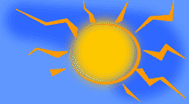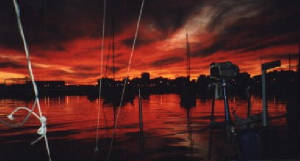|
 |
||||||||||
|
|
|||||||||||
|
We are just about ready to leave the Canaries again to go to Brazil and I
thought this was a good time to bring everyone up to date with how we've been getting on. With all our renovations in Northern
Ireland we didn't get to do all we'd planned nor did we get to see all the people we'd hoped to. In fact the time just flew
by and next time we return we'll have to stay much longer maybe even through a cold, dark, wet, winter - but then again maybe
not. We got a lot of work done to the boat and also were left with a lot to do when we arrived here in the islands. Living
in a house with Peter's father while he recuperated from his heart operation was fun and also a bit claustrophobic. It was
nice to go to sleep in a gale and know we wouldn't have to check the anchor in the middle of the night and endless hot water
running out of a tap can become addictive but then the view from the kitchen window was always the same, the t.v. was rubbish
and it rained a fair bit. We left Northern Ireland on 04.12.'97. with the solid fuel stove warming us as we looked out onto snow covered
Mourne mountains. We had a couple of days of nice weather then it all went sadly wrong and we ended up with southerly winds
where north easterlies should have been and we were hove to for a total of 15 days and most of the rest of the time we made
very little ground against strong head winds. The problem was that the Azores high pressure drifted away northwards settling
over Britain, giving you all nice crisp winter weather while the depressions sailed over us giving rainy southerly gales.
This lasted right up until Christmas day when we had a Fray Bentos steak and kidney pudding with some duty free Scotch as
our Christmas feast. We hadn't expected to be at sea for Christmas as the journey should have taken us between 12 and 16 days
not the 24 that it did. However it was a very comfortable trip as we didn't try to fight our way into the seas; we just sat
still; reading books and toasting our toes by the fire. It was a rare treat indeed to go outside for a look around at midnight
and smell the turf from the chimney all those miles from any land. By the time we reached the latitude of Gibraltar the weather
was warming up a bit and the wind shifted gradually to the west allowing us to sail a bit more; and when we caught our first
tuna fish we knew the worst was over. When we were in Lanzarote three years ago the main harbour of Arrecife had a charge for anchoring but not this
time so we made sure the anchor was well dug in and settled to do our interior woodwork but first we had some visitors from
Ireland. This was nice for us as it enabled us to do some touring inland which we had not done before and consequentally had
missed a very impressive island. It is mostly a barren volcanic island and one of the volcanoes is still quite active. The
last major eruption was in 1835 and the solidified rivers of lava still scar many parts of the island. They are sharp, jagged
and bare of growth apart from lichens. It reminded us of the volcanoes we had seen in Iceland but there lupins took over the
lava very quickly, here with hardly any rainfall that doesn't happen. On the older black volcanic soil they grow vines and
the island produces some very nice wine. The vines are grown in a depression in the ground surrounded by a semi circular wall
of lava rocks to protect it from the ferocity of the trade winds which blow strong, hot and sand laden from Africa. There
are millions of these little grottoes all over the hills and it is a most unusual sight which has been proclaimed a world
heritage site now. Last winter there was a higher than average rainfall on Lanzarote and the effect on plant life was very
impressive. Everywhere cactus were in bloom and wild flowers long asleep burst into vibrant life by the roadsides. Normally
it's a dull and drab island but this year it was glowing. This meant too that the winds were also from an unusual direction
and a lot of the islands' harbours suffered damage in the southerly gales. Arrecife has good all round shelter so we were
very disappointed when just before our last lot of visitors left the harbour authorities decided to start charging for anchoring.
At 5.00 per day to lie to your own tackle we couldn't afford to stay and so hoping that By early April we were keen to move on and sailed to the next island south, Fuerteventura, which is not so developed
as Lanzarote nor is it as pretty with most of the coastal scenery being sand dunes blown over the years from the Sahara. These
too had a fine beard of green growth on them; making them look a bit mouldy in fact. Unlike Lanzarote they were impoverished
by the growth as previously the gold of the sands glowed in the sun now they looked like sad piles of slag. Fuerteventura
means strong winds and we had excellent sailing conditions with gusty offshore breezes, smooth seas and a steep to coastline
- just the conditions we love. Leaving the island for Gran Canaria we decided to go overnight so as to see the comet. All
our anchorages up to now had been with land to the north and town lights obscuring the sky. We had a fine view but there was
a bright moon competing for some of the night. It must have been a brilliant sight in dark northern winter skies. We had a
cracking sail though arriving in Las Palmas just at dawn. After a couple of days there, again avoiding the harbour authorities
we sailed down here to Arguineguin. In the last five years we have spent more time here than anywhere else. We are anchored
again outside Anfi marina which is now finished. The timeshare too has grown out of all recognition and now has a hotel also.
Because of strict Spanish laws on rights of way and public beaches the gardens of the timeshare are open to all and they are
lovely. They've gone to a lot of trouble to plant a large selection of exotic species and lush grassy areas but at the price
they charge for the apartments they can well afford to. We have now got ourselves fully stocked up and all our plywood has
been used so it's time to move on. We have built a new wooden dinghy, sort of a shortened Mirror which we already have sails
for. We bought them at Beaulieu many years ago for 1 - including battens and spinaker!! We don't have a mast yet though.
Peter has been experimenting with drying meat and making biltong which has all turned out well while I have been making chutney,
pickles and pickling eggs. We also have bottled meat and chicken so along with the tins we bought in Britain and a freezer
full we have enough to be almost self-sufficient for about 1.5 years!! From our last experiences of prices in Brazil we will
need to be. The South African day charter catamaran that Peter did some work on before has been joined by another one and
both have been doing very well with up to 60 people twice a day at 30 per head but another Spanish run 120 ft. catamaran
has just started in competition to them so the prospects are grim. Speaking of catamarans an Irish one called "Happy Cat",
a Prout 50, came into Arrecife early in the new year. They had intended doing a quick circuit of the north Atlantic but were
delayed when in bad weather of the Scillies the bridge deck fell out off her - glug glug! They lost all forward of the saloon
i.e. 2 bedrooms and were left with the two hulls and whatever stiffeners held them together - what an experience. They were
lucky that no-one was in bed at the time or they'd have drowned. The boat was repaired at Falmouth and they continued on but
had decided to go back via Madeira and the Azores rather than go across. The South Africans lent us their south African charts to copy as we think we may be going there now. Our intentions
are to go to the Falklands and as we both want to see the island of South Georgia we may go eastwards which leaves a hard
beat to get back to South America. It is easier to go on to South Africa and do a circuit of the south Atlantic to get back
to the Falklands! |
|||||||||||
 |
|||||||||||
|
|
|||||||||||
